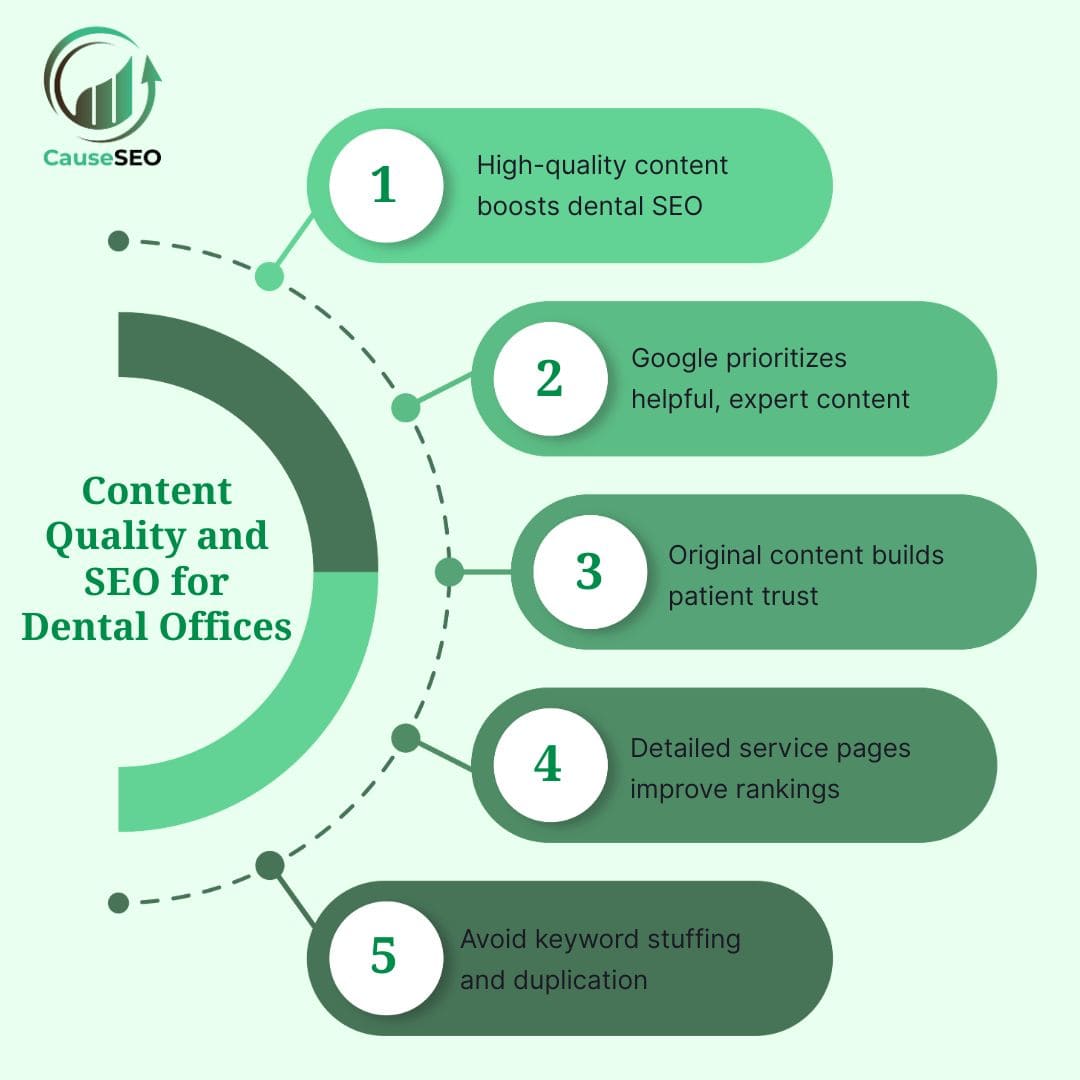Have you ever wondered why some dental practices consistently show up at the top of Google search results while others barely appear? The difference often comes down to content quality and it plays a much bigger role than most realize. In 2025, SEO for dental offices is not just about keywords or backlinks. It is about publishing helpful, trustworthy content that both patients and search engines find valuable.
This blog explores why content quality matters for dental SEO, how it affects rankings and patient trust, and what your practice can do to improve it. We will explain what high-quality content actually means, break down Google’s latest standards, and share actionable tips any dental team can follow. Whether you manage your own site or work with a dental SEO expert, understanding the role of content can give your practice a real edge online.

Why Content Quality Matters for Dental SEO
Google’s Quality Standards and Updates
Google continues to push for content that is helpful, accurate, and written with the user in mind. Updates like Helpful Content and E-E-A-T (Experience, Expertise, Authoritativeness, Trustworthiness) reflect this shift, especially in healthcare-related fields.
Thin, vague, or low-effort content often gets pushed down in search results. In Your Money or Your Life (YMYL) areas such as dentistry, Google demands higher quality. If your content does not meet that standard, your dental website SEO will likely struggle to compete.
Connection Between Quality Content and Patient Trust
Patients searching for a dentist are not just looking for services. They are looking for someone they can trust. High-quality content helps demonstrate expertise and care, which builds that trust.
Readable and accurate pages reduce bounce rates and improve conversions. This means patients stay longer on your site and are more likely to schedule an appointment.
Key Elements of High-Quality Dental Content
Depth and Accuracy
It is not enough to list that you offer implants or cleanings. Explain what those services involve. What can patients expect before, during, and after a procedure?
Be specific, and when appropriate, cite reliable sources such as the ADA or Mayo Clinic. Providing accurate, well-researched information is essential in dental SEO.
Unique and Original Content
Avoid copying text from suppliers or other clinics. Google can recognize duplicate content, and patients will notice when your website sounds like everyone else’s.
Instead, focus on what makes your practice different. Use original photos, share quotes from your team, and highlight success stories that happened in your office.
User Experience and Readability
Good content also needs to be easy to read and navigate. Use short paragraphs, bullet points, clear headings, and simple language. Make sure your site is mobile-friendly, with readable fonts and proper image alt text.
These improvements help both patients and search engines. They also boost engagement and lower bounce rates, improving your dental practice SEO over time.

How Content Quality Impacts SEO Performance
Ranking Factors Influenced by Content Quality
When visitors stay on your page, click through to other content, or engage with your calls to action, Google sees that as a good sign. These engagement signals can improve your rankings.
High-quality content also creates opportunities for strong internal linking, which helps both navigation and SEO for dental websites.
Local SEO Benefits
When your content is written with your specific location in mind, it can help your practice show up for searches like “dentist near me” or “emergency dentist in [city].”
Creating location-based blogs or service pages signals to Google that your office is relevant to those in your community. This is a key part of dental local SEO.
Common Content Mistakes Dental Sites Make
Keyword Stuffing or Misuse
Repeating phrases like “dental implants in New York” too often can make content hard to read and even lead to search penalties. Keyword stuffing hurts user experience and damages trust.
Instead, aim for natural integration of keywords like dental SEO services or SEO for dental office. Write with patients in mind, not just algorithms.
Outdated or Generic Content
If your last blog post was from 2019 or your service pages use canned text from suppliers, it is time for an update. Outdated or generic content signals that a site is not being maintained.
Patients expect modern treatments and up-to-date information. So does Google.
Lack of Internal Links or CTAs
A blog post that does not link to a booking page or related service is a missed opportunity. Internal links help guide visitors through your site and improve SEO.
Every page should also include a call to action. Whether it is “Book Now” or “Learn More About Our Services,” help your visitors take the next step.
Best Practices for Creating High-Quality Content That Ranks
Align with Patient Search Intent
Patients search for different reasons. Some want information, others want to compare providers, and some are ready to book.
Create content that meets each of these needs. Examples include “What to do for a chipped tooth” for informational intent and “dentist open late in Toronto” for transactional intent. Matching content to intent improves SEO for dental practices.
Use On-Page SEO with Quality in Mind
Make sure your title tags, H1 headings, and meta descriptions are clear and include relevant keywords. Optimize your images with alt text and use structured data markup when possible.
Adding schema for FAQs or How-To sections can enhance your visibility in search results and increase click-through rates.
Maintain a Content Schedule and Audit Strategy
High-performing dental websites publish regularly and revisit old pages. Plan for monthly or biweekly blogs and check your main service pages every 6 to 12 months.
Update old content with fresh formatting or new information. This shows Google your site is active and reliable.

FAQs About Content Quality and Dental SEO
How does Google define high-quality content?
It should be original, helpful, and written with expertise. It must also be easy to read and relevant to what users are searching for.
How often should a dental office update its content?
Blog content can be added monthly. Core pages like services should be reviewed and refreshed every 6 to 12 months.
Can AI-generated content rank in Google?
Only if it is reviewed and edited by humans. Unedited AI content often lacks accuracy and tone, and it may harm your rankings.
Does content quality affect Google Maps or local pack rankings?
Yes, indirectly. Strong content supports your site’s authority and relevance, which helps with local SEO visibility.
What type of content works best for dental SEO?
Detailed service pages, FAQs, blog posts with real value, and case studies tend to perform best.
Conclusion
In 2025, content quality plays a central role in both search visibility and patient experience. It helps your dental office rank higher, earn trust, and attract new patients.
As Google continues to raise the bar, only helpful, human-centered content will stand out. Dental offices that invest in content quality today will see long-term results.
If your website needs a content refresh or a complete strategy, let the team at CauseSEO help. Our dental SEO experts create content that ranks, connects, and converts.

